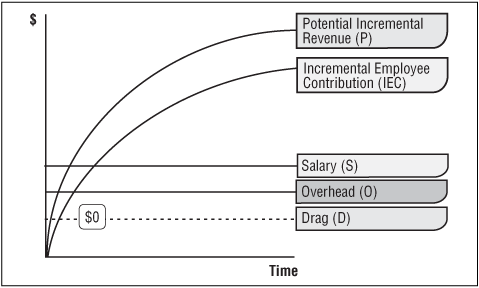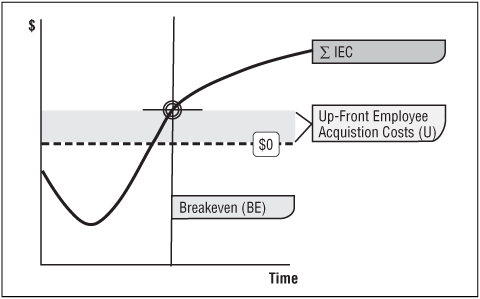The Incremental Employee Contribution Model
The Incremental Employee Contribution or IEC model combines the concepts described above; a simplified version is described here. Mathematically, the incremental value that an employee provides within the system can be described as:
| Pt | Potential incremental revenue on day t attributable to this employee. |
| St | Salary cost on day t for this employee. |
| Dt | Drag cost on day t. |
| Ot | Allocated overhead cost on day t. |
| U | Total up-front acquisition cost for this employee. |
Graphically these relationships are shown in Figure 4.1.
Figure 4.1.

Descriptively, this model is a statement of the following inputs, effects, links, and causality.
The longer employees are on the job, the more productive they become. Learning theory supports this proposition and allows for the quantification of a learning curve, which relates the level of productivity, skill, capacity, or capability to length of time on the job (Teplitz 1991).
System resources in the form of such things as training materials, additional management oversight, and so on.
Overhead costs are constant over time.
Salary stays steady over time.
The incremental value of an employee is negative on the first day, becomes positive over time, and then eventually levels out at a steady rate of productivity (asymptotic).
Each of these statements involves some implicit or explicit set of assumptions and beliefs. These points are oversimplified for illustration purposes (for example, one would not realistically expect that the salary level would remain constant over time).
Each individual employee tracks to a different trajectory along these curves. However, it is not necessary to quantify the exact trajectory for each and every employee. The goal is to build a robust enough model that allows us to weigh broader issues.
From an asset valuation perspective, an important question becomes, “At what point in time has a new employee broken even in terms of investment?” Alternatively, “What is the payback period?” One detail worth mentioning is the scale of the Y axis. We are not interested in the absolute value of the productive output, but rather the relative value to other employees in the system.
The key concept here is the Fully Effective Employee, one who is up to speed and performing the job within established quality and productivity guidelines. While it may be possible to determine the exact dollar value of production from an employee at a given time (probably only in the simplest job categories), it is not necessary in order to support the decision framework and would require a great deal more work. There will be many situations where we do not know the value of the efforts the employee makes but we do have an idea of their relative productivity.
Using the model, we can accumulate the incremental value over time and account for the initial outlay required to acquire the asset; see Figure 4.2.
Figure 4.2.

This graph of the cumulative IEC shows information that was not easily deduced from either the mathematical model, or the nonaccumulated IEC graph. This is the essence of modeling, abstracting from the real world system to something more cognitively tractable when making our decision. From the graph, the cumulative value of an employee decreases over an initial period and then increases. At some point it becomes greater than zero and at another it rises above the acquisition cost to achieve break-even status, the date that defines the end of the payback period. The graph also shows that the worst time to lose an employee is at the bottom of that initial trough, the point at which the cumulative value is the lowest.
